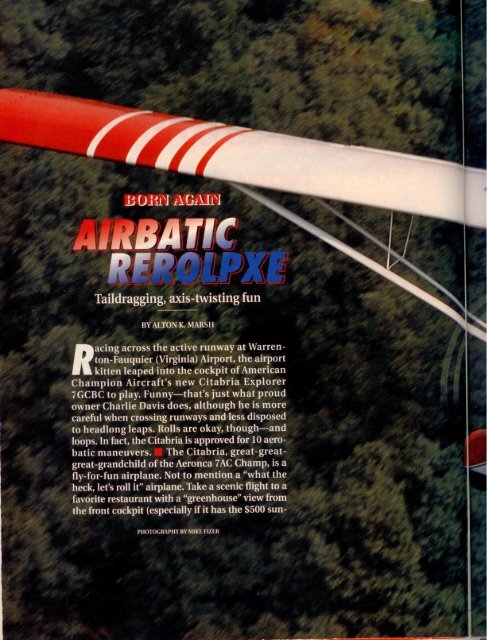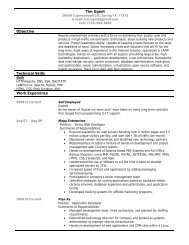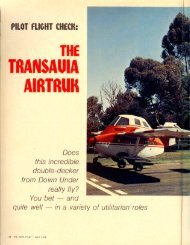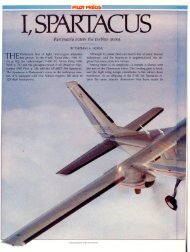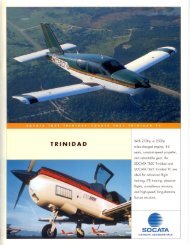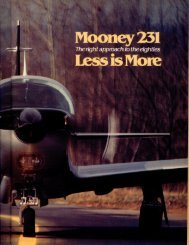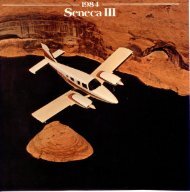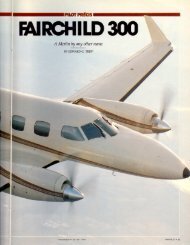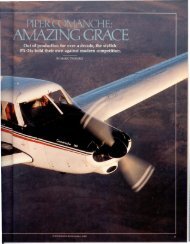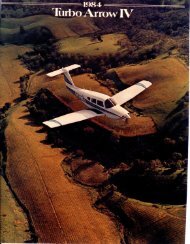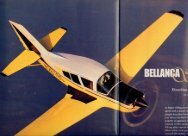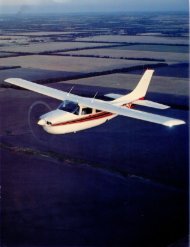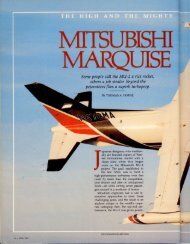0[56 knots indicated. - Aero Resources Inc
0[56 knots indicated. - Aero Resources Inc
0[56 knots indicated. - Aero Resources Inc
You also want an ePaper? Increase the reach of your titles
YUMPU automatically turns print PDFs into web optimized ePapers that Google loves.
oof option), and have an aileron roll<br />
along the way as an appetizer. The factory<br />
calls it a "Champ on steroids with<br />
flaps." (And in case you have forgotten<br />
where the name Citabria came from,<br />
spell our headline backward.)<br />
American Champion President<br />
Jerry Mehlhaff is banking on the<br />
Explorer being much more than a fun<br />
machine, of course. Intended as a<br />
lower-priced competitor to the Piper<br />
Super Cub, Mehlhaff sees it as a utility<br />
aircraft, whether it be on floats or skis,<br />
and as a glider tug aircraft.<br />
There were 1,214 Citabria 7GCBC<br />
aircraft produced before Bellanca Aircraft<br />
Corporation ceased production.<br />
The first Citabria came off the line in<br />
1964 at Champion<br />
•<br />
Aircraft in Oseola,<br />
The Citabria is<br />
a fly-for-fun,<br />
"what the heck,<br />
let's roll it"<br />
airplane.<br />
Wisconsin, a company that was later<br />
bought by Bellanca. Eventually, the<br />
Citabria line expanded to four models.<br />
The 7ECA, a flap less, lIS-horsepower<br />
model, is scheduled to be revived by<br />
American Champion next spring-in<br />
time for Sun 'n Fun. The 7GCAA was<br />
basically the same as the 7ECA, but<br />
with a 150.hp engine. American<br />
Champion expects to begin building<br />
the 7GCM in a year, but with a 160-hp<br />
engine. The new Ceconite-covered<br />
7GCBC has a 160-hp engine, flaps (as<br />
did the original aircraft), and longer<br />
wings with metal spars. Owners of<br />
older 7GCBC aircraft may purchase<br />
the metalized wings for $12,000,<br />
increasing the aircraft's maximum<br />
gross weight from 1,650 pounds to<br />
1,800 pounds. Older Citabria 7GCBC<br />
aircraft produced in the 1960s and<br />
1970s had wood spars that are prone<br />
to cracking. In addition, metal ribs<br />
were nailed to spars, but the nails<br />
would pull out. Further improvements<br />
to the 7GCBC include use of the heftier<br />
front wing strut from a Decathlon,<br />
which is attached to the wing with a<br />
beefed-up end fitting.<br />
The fourth model, the 7KCAB, was<br />
basically a 7GCAA with an inverted<br />
fuel and oil system, but will not be<br />
54 • OCTOBER 1994
evived by American Champion. That<br />
model was abandoned by aerobatic<br />
enthusiasts in favor of the Champion<br />
Decathlon 8KCABbecause of its better<br />
inverted flight performance.<br />
While the Explorer is fully aerobatic,<br />
although with a restricted weightand-balance<br />
envelope when flown for<br />
aerobatics, the flight manual warns of<br />
loss of oil pressure and oil during negative<br />
maneuvers. The flight manual,<br />
by the way, is printed on four sheets of<br />
paper and stapled together. (The<br />
Citabria was certified under older CAR<br />
4a regulations, when a more extensive<br />
flight manual was not required.) The<br />
180-hp Decathlon, already in production<br />
at American Champion, is the<br />
•<br />
company's biggest seller-accounting<br />
When it comes<br />
to taildraggers,<br />
the Citabria is<br />
as tame as the<br />
airport kitten.<br />
for 16 of the 18 sales made so far this<br />
year (see "The New Champion," October<br />
1991 Pilot).<br />
When it comes to taildraggers<br />
(more formally known as conventional-gear<br />
aircraft), the Citabria is as<br />
tame as the airport kitten. Excellent<br />
visibility over the nose-it is soloed<br />
from the front-simplifies taxiing,<br />
takeoffs, and landings. The Explorer<br />
gave no hint of wanting to swap ends<br />
during landings and takeoffs from<br />
Warrenton, where there was a slight<br />
crosswind. Like the original, it can<br />
handle a hefty 17-knot crosswind.<br />
The sporty red, white, and blue urethane<br />
paint scheme of N50AC, the<br />
company prototype aircraft bought by<br />
Davis, signals fun even while sitting on<br />
the ramp. Because it was a prototype,<br />
there are extra electrical leads tied off<br />
in a bundle near the oil filler port that<br />
once fed operating temperatures to a<br />
thermocouple and meter in the back<br />
seat. Testing required recording even<br />
the operating temperatures of the<br />
magnetos while in flight.<br />
Cockpit switches and controls will<br />
be familiar to anyone who has flown<br />
an older Decathlon or Citabria,<br />
although circuit breakers have been<br />
modernized. The magneto, master,<br />
AOPA PILOT • 55
and other switches are, like the older<br />
models, rather inconveniently located<br />
behind the pilot's left shoulder. Operating<br />
them while strapped into a parachute<br />
and with the front cockpit's fivepoint<br />
harness hooked up requires<br />
more than a few grunts. It's easier<br />
from the back seat, but that's not<br />
where you solo this aircraft. The trim<br />
control, same as that used on earlier<br />
Citabrias and Decathlons, is a sliding<br />
knob, much like the throttle, that is<br />
fast and simple to operate.<br />
Spend a few seconds savoring the<br />
new-airplane smell (the aircraft had<br />
only 32 hours on it), punch the shiny<br />
electric starter button while holding<br />
the toe brakes, and it's time to fly.<br />
Davis elected to have instructor<br />
•<br />
Using the Explorer<br />
to give tailwheel<br />
transition training to<br />
a nosewheel pilot is<br />
almost cheating.<br />
Chuck Davis, no relation, ride along<br />
on the demonstration flight, because<br />
the instructor was more familiar with<br />
landings and takeoffs from the rear<br />
seat. With less than half tanks, we<br />
were still right at the new, higher gross<br />
weight of 1,800 pounds. Takeoffs are<br />
performed with two notches of flaps<br />
(16 degreesh which cuts 120 feet off<br />
the takeoff run. A few seconds of<br />
rolling at full power, a gentle forward<br />
pressure to raise the tail, a gentle pull,<br />
and we were off in what appeared to<br />
be less than 500 feet. Tracking the runway<br />
centerline required little effort.<br />
Using the Explorer to give tailwheel<br />
transition training to a nosewheel<br />
pilot is almost cheating, given the aircraft's<br />
well-mannered behavior.<br />
The Explorer is equally docile during<br />
stalls, proving its value as a trainer.<br />
With the stick held back after the gentle<br />
break during an approach-to-Ianding<br />
stall, the aircraft tracked nearly<br />
straight ahead, finally settling into a<br />
medium-bank turn to the left. Slow<br />
flight was performed at 35 to 40 <strong>knots</strong><br />
with flaps down. During faster maneuvers,<br />
such as those required during<br />
aerobatics, the ailerons seemed slightly<br />
stiff. American Champion Vice President<br />
for Engineering Jerry Mehlhaff,<br />
<strong>56</strong> • OCTOBER 1994
Jr., son of the president, admitted the<br />
ailerons in the original design have a<br />
"high hinge moment." Purchasing<br />
optional spades (shovel-like paddles<br />
mounted to the ailerons) for $550 will<br />
reduce aileron forces by one third, he<br />
said. <strong>Aero</strong>batic maneuvers for which<br />
the Citabria is approved include the<br />
chandeIle, lazy eight, barrel or slow<br />
roll, Immelmann, loop, split S, snap<br />
roll, hammerhead turn, Cuban eight,<br />
and spin.<br />
The flaps offer an impressive six<br />
positions, as did the flaps in the original<br />
7GCBC, but all positions add more<br />
lift than drag, Mehlhaff, Jr. said, making<br />
them ineffective in controlling the<br />
descent during a landing. Additionally,<br />
the positioning<br />
•<br />
of the flap handle<br />
Slipping as needed with<br />
partial flaps worked<br />
quite well, maintaining<br />
afinal approach speed<br />
0[<strong>56</strong> <strong>knots</strong> <strong>indicated</strong>.<br />
Anyone familiar with a Decathlon<br />
will feel at home in the Explorer cockpit.<br />
The upper left panel switches are<br />
difficult to reach from the pilot's front<br />
seat. A fully opening left window<br />
keeps the cockpit coolon the ground.<br />
offers little leverage advantage. The<br />
last two positions, 27 degrees and 35<br />
degrees, are a tough pull.<br />
Each of three approaches required<br />
a forward slip because the flaps were<br />
of little help. Instructor Davis said the<br />
aircraft requires a long, flat approach,<br />
but that was inhibited somewhat at<br />
Warrenton by trees off the approach<br />
end. Slipping as needed with partial<br />
flaps worked quite well, maintaining a<br />
final approach speed of <strong>56</strong> <strong>knots</strong> <strong>indicated</strong>.<br />
Both instructor Davis and owner<br />
Davis cautioned prior to the flight that<br />
the airplane likes to float on landing.<br />
<strong>Inc</strong>reased wing rigidity is to blame for<br />
the float, Mehlhaff, jr. said. The wing,<br />
downsized from a Champion Scout,<br />
was intentionally made more rigid to<br />
improve lift and roll rate. It offers the<br />
added advantage of increasing wing<br />
strength. "It reduces a lot of problems,"<br />
Mehlhaff, jr. said. However, the<br />
floating problem didn't seem serious<br />
during the three approaches I made:<br />
The first, with no previous experience<br />
in the aircraft, took 1,500 feet, but the<br />
last was accomplished in less than<br />
1,000 feet-not that far off the factory<br />
claim of 740 feet over a 50-foot obstacle.<br />
Further practice would reduce the<br />
AOPA PilOT • 57
landing distance still farther.<br />
One point did seem worrisome,<br />
however. To aid in getting down, it is<br />
recommended that power be reduced<br />
to idle opposite the point of intended<br />
touchdown. That's not as serious a<br />
problem in summer, but what about<br />
shock-cooling the engine in winter<br />
Owner Davis plans to carry a little<br />
power to touchdown in winter but<br />
may need to develop new techniques<br />
Citabria Explorcr 7GCBC<br />
Base price: $58.900<br />
Price as tested: $72.475<br />
Spccifications<br />
Powerplant Textron Lycoming 0-320-H2B.<br />
160 hp at 2.700 rpm<br />
Hecommended TBO 2.000 hr<br />
Propeller Sensenich 74DM6S8-1. 73-in dia,<br />
Length<br />
Wingspan<br />
Seats<br />
Cabin width<br />
Empty weight<br />
Gross weight<br />
Useful load<br />
Payload with full fuel<br />
Fuel capacity<br />
Oil capacity<br />
Baggage capacity<br />
Wheelbase<br />
Max G loading<br />
Performancc<br />
Takeoff distance, ground roll,<br />
16-degree flap setting<br />
<strong>56</strong>-pitch climb prop<br />
22.1 ft<br />
34.5 ft<br />
Two. tandem<br />
28in<br />
1,250lb<br />
1,800lb<br />
550lb<br />
340lb<br />
36 gal (35 gal usable)<br />
8 qt<br />
100lb<br />
6.5 ft<br />
+5/-2<br />
412 ft<br />
to get the aircraft down such as starting<br />
the forward slip during base or<br />
even on downwind. The Explorer really<br />
does like to fly.<br />
This particular Explorer is equipped<br />
with a radio, transponder with<br />
encoder, intercom, and even a II Morrow<br />
GPS.<br />
Overall, the aircraft delivers what it<br />
promises: fun. I asked Charlie if I<br />
could come back-just to play. 0<br />
Takeoff distance over 50-ft obstacle.<br />
16-degree flap setting<br />
6<strong>56</strong> ft<br />
Max demonstrated crosswind<br />
component<br />
Hate of climb, sea level<br />
17 kt<br />
I.130fpm<br />
Cruise speed/endurance w/45-min<br />
rsv @ 75% power 110 to 112 kt/3.3 hr<br />
Service ceiling<br />
16.000 ft (estimated)<br />
Landing distance<br />
over 50-ft obstacle 740 ft (estimated)<br />
Landing distance, ground roll 360 ft (estimated)<br />
Limiting and Hecommcndcd Airspecds<br />
Vx (best angle of climb)<br />
61 KIAS<br />
Vy (best rate of climb)<br />
68 KIAS<br />
V"o (max structural cruising) 104 KIAS<br />
VS1 (stall, flaps up)<br />
44 KIAS<br />
Vso (stall, flaps down)<br />
41 KIAS<br />
For more il/formatiol/, contact American Champion<br />
Aircraft. Post Office Box 37,32032 Washi/lgto/l<br />
Ave/lue, Highway D, Rochester. Wisco/lsin<br />
53167; telephone 800/223-9381 or 414/534 -6315.<br />
All specifications are based on manufacturer's<br />
calculations. All performa/lce figures are based on<br />
standard day. standard atmosphere. sea level.<br />
gross weight co/lditions unless otherwise /loted.<br />
58 • OCTOBER 1994


